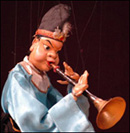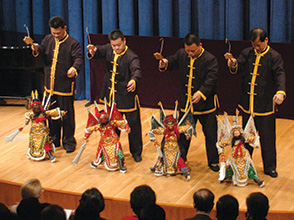Watch a Video
The Quanzhou Marionette Theater perform excerpts from Lantern Festival and The Young Monk Going to Town.
Courtesy of Quanzhou Marionette Theater.
Related Essays
Puppet Opera

In China human opera has fared much better than puppet opera, but the latter is in some ways even more mesmerizing. The main life of both is in the vibrant calendar of temple fairs; opera serves the gods as much as mortals, with the stage before the temple. Highlighted below are two pockets of activity, from the northwest and southeast.
In northwest China, shadow puppetry clings on in poor rural areas of Gansu and Shaanxi provinces. In Shaanxi, the Zhang Family Band, based in a village near the Huashan mountains just east of Xi’an, tours the nearby countryside to perform their rugged dramas at temple fairs and rituals for the well-being of families. The guttural, hoarse singing is accompanied by percussion, fiddle, lute, and shawm.
Far away in southeast China, Quanzhou city is the hub of the thriving local Hokkien cultures of south Fujian (Minnan) that extends to the island of Taiwan and the diaspora. Apart from several types of puppets, shawm and percussion ensembles, dance troupes, and exquisite nanguan vocal chamber music—as well as amazing household Daoist traditions just as lively as in Shanxi—all convene for huge local communal religious celebrations; puppeteers also take part in consecration rituals for new dwellings. Larger official troupes like the Quanzhou marionettes remain firmly based in this culture, despite adapting to secular demands, with their high international profile reflected in their 2008 appearance at the Beijing Olympics. After the opening invocation to the gods, the dramas proper feature both comedy and more serious ritual concerns. Developments in the puppets themselves, their virtuosic string manipulation, and more opulent musical arrangements and staging, all seek a wider range of expression than the traditional chamber-style format.
Chinese opera plots are taken from famous legends of the long imperial period, also familiar in fiction—and fall into two main categories: martial, such as famous battles and righteous rebellions, and civil, like romances between young scholars and maidens. Beyond mere acrobatic pageantry, they also express intimate feelings through recitation and vocal melody accompanied by strings, wind, and ubiquitous percussion.


